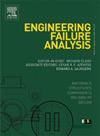高镍奥氏体铸铁潜水电泵失效分析及机理研究
IF 4.4
2区 工程技术
Q1 ENGINEERING, MECHANICAL
引用次数: 0
摘要
潜水泵在采油过程中起着关键作用,但其叶轮和导叶的故障往往造成事故,导致产能较低。本研究从微观材料学的角度出发,通过宏观形貌分析、光学显微镜(OM)、金相分析、扫描电镜(SEM)、能谱分析(EDS)、化学成分分析等试验,结合流体力学和现场工况,对渤海某油田生产井中高镍合金潜水泵的失效机理进行了分析。结果表明:导叶的勺状孔洞与机匣的勺状孔洞呈水平对准;在射孔部位观察到犁头状微观结构。此外,在泵内发现了大量的白色陶瓷球。由此推断,泵的失效模式为携带颗粒的流体磨损导叶和机匣,导致射孔。导叶基体中的c型石墨是产生冲蚀磨损的本质原因,对抗冲蚀性能有负面影响。泵壳组织中珠光体的比例较高,导致基体耐磨性降低。本文章由计算机程序翻译,如有差异,请以英文原文为准。
Failure analysis and mechanism study of submersible electric pump made of high nickel austenitic cast iron
Submersible electric pump plays a key role in the oil extraction, however, the failure of the impeller and guide vane often causes accidents, resulting in lower deliverability. In this study, the failure mechanism of high nickel alloy submersible electric pumps in the production wells of an oilfield in Bohai Sea was analyzed from the perspective of micro-materials science by carrying out tests such as macro-morphological analysis, optical microscope (OM), metallographic analysis, scanning electron microscope (SEM) and energy spectrum analysis (EDS), chemical composition analysis, and combining with the hydrodynamics and on-site working conditions. The results show that the spoon-like perforation of the guide vane is in horizontal alignment with the spoon-like perforation of casing. And plough-like microstructure is observed in the perforation position. Besides, a large number of white ceramic balls is discovered in the pump. Therefore, it is inferred that the failure mode of the pump is that the fluid carrying particles wear the guide vane and casing, resulting in perforation. The C-type graphite in the matrix of the guide vane is the essential reason of the erosion wear, which has a negative impact on the erosion resistance. The proportion of pearlite in the microstructure of the pump casing is relatively high, resulting in a decrease in the wear resistance of the matrix.
求助全文
通过发布文献求助,成功后即可免费获取论文全文。
去求助
来源期刊

Engineering Failure Analysis
工程技术-材料科学:表征与测试
CiteScore
7.70
自引率
20.00%
发文量
956
审稿时长
47 days
期刊介绍:
Engineering Failure Analysis publishes research papers describing the analysis of engineering failures and related studies.
Papers relating to the structure, properties and behaviour of engineering materials are encouraged, particularly those which also involve the detailed application of materials parameters to problems in engineering structures, components and design. In addition to the area of materials engineering, the interacting fields of mechanical, manufacturing, aeronautical, civil, chemical, corrosion and design engineering are considered relevant. Activity should be directed at analysing engineering failures and carrying out research to help reduce the incidences of failures and to extend the operating horizons of engineering materials.
Emphasis is placed on the mechanical properties of materials and their behaviour when influenced by structure, process and environment. Metallic, polymeric, ceramic and natural materials are all included and the application of these materials to real engineering situations should be emphasised. The use of a case-study based approach is also encouraged.
Engineering Failure Analysis provides essential reference material and critical feedback into the design process thereby contributing to the prevention of engineering failures in the future. All submissions will be subject to peer review from leading experts in the field.
 求助内容:
求助内容: 应助结果提醒方式:
应助结果提醒方式:


